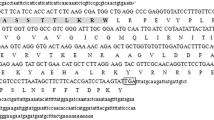Abstract
We have isolated a cDNA clone, called pLg106, which corresponds to a negatively light-regulated mRNA in the aquatic monocot Lemna gibba. Lg106 mRNA is more abundant in dark-treated plants than in plants grown under continuous white light. The levels of Lg106 mRNA reached a maximum 12–24 hours after plants had been placed in the dark. In vitro-labelled transcripts from nuclei isolated from white light-grown and darktreated Lemna hybridized equally to Lg106 DNA, indicating that transcription of the Lg106 gene was similar in both white light and darkness. Therefore, the higher level of Lg106 mRNA in the dark was not attributable to a change in transcription. We suggest that the stability of Lg106 mRNA is affected by changes in illumination. The steady-state level of Lg106 did not appear to be under phytochrome regulation, as the abundance of Lg106 mRNA from plants grown in intermittent red light or intermittent red followed immediately by far-red light was not significantly different from that of dark-treated plants. The size of the mRNA was estimated to be 650–700 nt. Genomic Southern blots indicated the presence of a single gene for Lg106. The Lg106 cDNA was sequenced and examined for similarities to nucleotide sequences in GenBank.
Similar content being viewed by others
References
Alexander DC, McKnight TD, Williams BG: A simplified and efficient vector-primer cDNA cloning system. Gene 31: 79–89 (1984).
Bohlmann H, Apel K: Isolation and characterization of cDNAs coding for leaf-specific thionins closely related to the endosperm-specific hordothionin of barley (Hordeum vulgare L.). Mol Gen Genet 207: 446–454 (1987).
Buchanan BB: Role of light in the regulation of chloroplast enzymes. Ann Rev Plant Physiol 31: 341–374 (1987).
Fischer RL, Goldberg RB: Structure and flanking regions of soybean seed protein genes. Cell 29: 651–660 (1982).
Flores S, Tobin EM: Benzyladenine modulation of the expression of two genes for nuclear-encoded chloroplast proteins in Lemna gibba: Apparent post-transcriptional regulation. Planta 168: 340–349 (1986).
Frankland B, Taylorson R: Light control of seed germination. In: Pirson A, Zimmermann MH (eds) Encyclopedia of Plant Physiology, Vol. 16A, pp. 428–456. Springer-Verlag, Berlin (1983).
Kasemir H: Light control of chlorophyll accumulation in higher plants. In: Shropshire W, Mohr H (eds) Encyclopedia of Plant Physiology, Vol. 16B, pp. 662–686. Springer-Verlag, Berlin (1983).
Kohorn BD, Harel E, Chitnis PR, Thornber JP, Tobin EM: Functional and mutational analysis of the light-harvesting chlorophyll a/b protein of thylakoid membranes. J Cell Biol 102: 972–981 (1986).
Kuhn DN, Chappell J, Boudet A, Hahlbrock K: Induction of phenylalanine ammonia-lyase and 4-coumarate: CoA ligase mRNAs in cultured plant cells by UV light or fungal elicitor. Proc Natl Acad Sci USA 81: 1102–1106 (1984).
Mösinger E, Batschauer A, Schäfer E, Apel K: Phytochrome control of in vitro transcription of specific genes in isolated nuclei from barley (Hordeum vulgare). Eur J Biochem 147: 137–142 (1985).
Oelmüller R, Mohr H: Mode of coaction between blue/UV light and light absorbed by phytochrome in light-mediated anthocyanin formation in the milo (Sorghum vulgare Pers.) seedling. Proc Natl Acad Sci USA 82: 6124–6128 (1985).
Pustell J, Kafatos FC: A convenient and adaptable package of DNA sequence analysis programs for microcomputers. Nucl Acids Res 10: 51–59 (1982).
Quail PH: Phytochrome: a regulatory photoreceptor that controls the expression of its own gene. Trends Biochem Sci 9: 450–453 (1984).
Richter G: Blue light control of the level of two plastid mRNAs in cultured plant cells. Plant Mol Biol 3: 271–276 (1984).
Sanger F, Coulson AR, Barrell BG, Smith AJH, Roe BA: Cloning in single-stranded bacteriophage as an aid to rapid DNA sequencing. J Mol Biol 143: 161–178 (1980).
Schäfer E, Haupt W: Blue-light effects in phytochrome-mediated responses. In: Shropshire W, Mohr H (eds) Encyclopedia of Plant Physiology, Vol. 16B, pp. 723–744. Springer-Verlag, Berlin (1983).
Shepherd JCW: Method to determine the reading frame of a protein from the purine/pyrimidine genome sequence and its possible evolutionary justification. Proc Natl Acad Sci USA 78: 1596–1600 (1981).
Silverthorne J, Tobin EM: Demonstration of transcriptional regulation of specific genes by phytochrome action. Proc Natl Acad Sci USA 81: 1112–1116 (1984).
Southern EM: Detection of specific sequences among DNA fragments separated by gel electrophoresis. J Mol Biol 98: 503–517 (1975).
Stiekema WJ, Wimpee CF, Silverthorne J, Tobin EM: Phytochrome control of the expression of two nuclear genes encoding chloroplast proteins in Lemna gibba L. G-3. Plant Physiol 72: 717–724 (1983).
Thomas PA: Hybridization of denatured RNA and small DNA fragments transferred to nitrocellulose. Proc Natl Acad Sci USA 77: 5201–5205 (1980).
Tobin EM, Silverthorne J: Light regulation of gene expression in higher plants. Ann Rev Plant Physiol 36: 569–593 (1985).
Vince-Prue D: Photomorphogenesis and flowering. In: Shropshire W, Mohr H (eds) Encyclopedia of Plant Physiology, Vol. 16B, pp. 457–490. Springer-Verlag, Berlin (1983).
vince-Prue D, Canham AE: Horticultural significance of photomorphogenesis. In: Shropshire W, Mohr H (eds) Encyclopedia of Plant Physiology, Vol. 16B, pp. 518–544. Springer-Verlag, Berlin (1983).
Virgin HI, Egneus HS: Control of plastid development in higher plants. In: Pirson A, Zimmermann MH (eds) Encyclopedia of Plant Physiology, Vol. 16A, pp. 289–311. Springer-Verlag, Berlin (1983).
Wimpee CF, Stiekema WJ, Tobin EM: Sequence heterogeneity in the RuBP carboxylase small subunit gene family of Lemna gibba. In: Goldberg RB (ed) Plant Molecular Biology, UCLA Symposium on Molecular and Cellular Biology, Vol. 12, pp. 391–401. Alan R. Liss, New York (1983).
Author information
Authors and Affiliations
Rights and permissions
About this article
Cite this article
Okubara, P.A., Flores, S. & Tobin, E.M. Characterization of a negatively light-regulated mRNA from Lemna gibba . Plant Mol Biol 11, 673–681 (1988). https://doi.org/10.1007/BF00017467
Received:
Accepted:
Issue Date:
DOI: https://doi.org/10.1007/BF00017467




